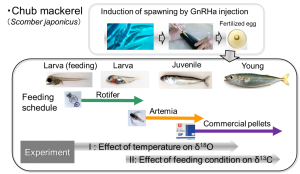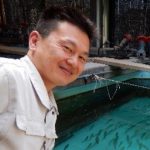Michio Yoneda
Development of databank for environmental history of chub mackerel and Japanese sardine using otolith
Research Summary
Chub mackerel and Japanese sardine in waters off Japan show cyclic and dramatic population dynamics in relation to climate changes at multidecadal scales in various marine ecosystems. However, the mechanisms connecting such fish population dynamics to physical and biological environments remain unclear. Chub mackerel and Japanese sardine experience mass mortality in early stage of life and the degree of survival of larvae and juveniles could be related to the abundance of population at a given season. Thus, exploration of environmental history of individual fishes, especially in early stage of life, should be one of the keys to clarify the influence of environmental conditions on population dynamics: e.g. Where were larvae and/or juveniles born? Where did they grow and/or develop?
Fish otolith exhibit growth ring marks that are often formed regularly (e.g. daily and yearly) over the time scales. This enable us to examine the birth date and growth rate of individual fishes. Also, otolith is composed of calcium carbonate involving the trace elements from the water individuals have occupied. The stable oxygen isotope (δ18O) could reflect physical environment (water temperature and salinity) while the stable carbon isotope (δ13C) may be related to metabolism and feeding environment. These isotopic markers in the otolith, as a proxy of environmental history, may lead to understand where the fish have migrated and what they have eaten. To confirm this possibility, the empirical evidence of the relationship between the isotopic markers and environmental conditions needs in both species.
In this study we explore the effects of physical and biological environments on δ18O and δ13C in the otolith of chub mackerel and Japanese sardine under captive conditions.
Principal Investigator:
Michio Yoneda
National Research Institute of Fisheries and Environment of Inland Sea, Hakatajima Station, Japan Fisheries Research and Education Agency
Collaborators:Mitsuo Nyuji National Research Institute of Fisheries Science, Japan Fisheries Research and Education Agency
Collaborators:Masahiro Nakamura National Research Institute of Fisheries and Environment of Inland Sea, Hakatajima Station, Japan Fisheries Research and Education Agency
Joint Cooperators:Kengo Ohta National Research Institute of Fisheries and Environment of Inland Sea, Hakatajima Station, Japan Fisheries Research and Education Agency
Joint Cooperators:Takashi Yamashita National Research Institute of Fisheries and Environment of Inland Sea, Hakatajima Station, Japan Fisheries Research and Education Agency
Joint Cooperators:Satoshi Takeshima National Research Institute of Fisheries and Environment of Inland Sea, Hakatajima Station, Japan Fisheries Research and Education Agency



